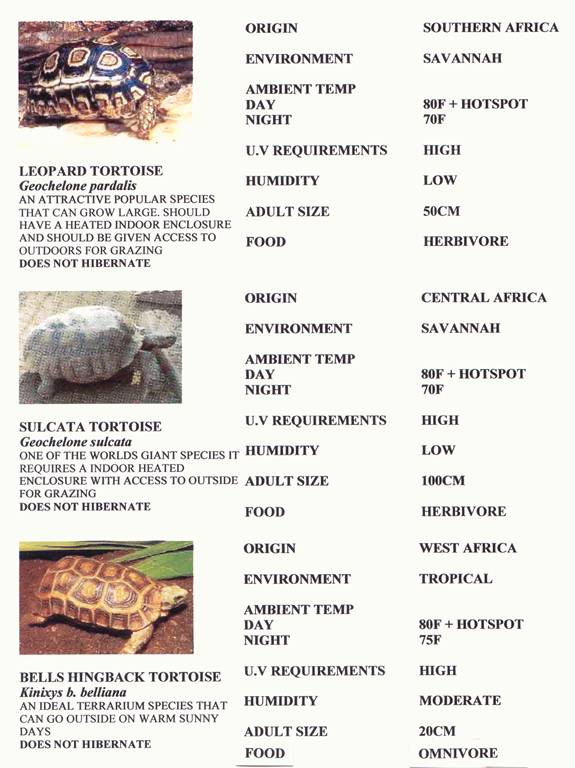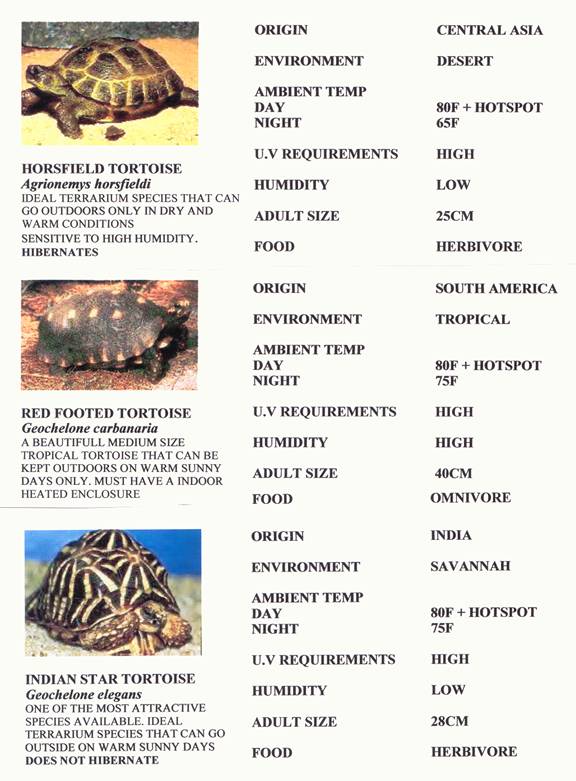TORTOISE CARE
Tortoises are long-lived, well armored, and usually slow-moving. Their potential life span of 50 to 100 years requires a certain knowledge and commitment on the part of the keeper. Although there are 50 living species worldwide, the United States has only three, the gopher tortoise, the desert tortoise from the southwest, and the Texas tortoise. Either state or federal laws protect all three. Tortoises vary greatly in size. Smaller species such as spur-thighed tortoises seldom reach a length of 10”. Leopard tortoises attain a maximum length of 23” and weights of 70 pounds. Galapagos tortoises can grow to 36” or more.
Their habitat requirements are also quite different. Species such as spur-thighed, desert, and leopard tortoises come from drier environments and their diet should contain more roughage, dried grasses, and cactus pads. Red-footed and yellow-footed tortoises live in the South American rain forest and need more humidity as well as more fruit and vegetables in their diet.
HOUSING:
INDOOR
- Glass aquarium - 20 gallon tank for hatchlings, larger tank or pen as they increase in size
- Lid to prevent drafts and allows ventilation, also to protect tortoise from other pets/predators
- UV light source (ESU Desert 7% UVB Reptile Daylight Lamp or Zoo Med Reptisun 5.0 UVB)
Incandescent Daylight bulb, 100 watt as heat source, temperature ranges 85° to 90°F (ESU Reptile Bright Light or Hagen DayGlo - stimulates natural sunlight)
- Incandescent Night light bulb, 75 to 100 watt as heat source, temperature range 75° to 80°F (ESU Reptile Night Light or Hagen NightGlo - stimulates natural moonlight)
- Thermometer and humidity gauge, place under heat source to monitor area temperature
- Provide one hiding spot per animal. It should resemble a small, dark cave to provide security for the tortoise. Temperature ranges 75° to 80°F.
- Shallow water dish to soak your tortoise in twice a week for 30 minutes. The water level should never be deeper than eye level to prevent drowning, since tortoises are inefficient swimmers.
OUTDOOR
- Outdoor enclosures should have retaining walls with an inside lip to prevent the tortoise from climbing over
- Fencing should be buried 12" deep then surrounded with gravel to discourage burrowing.
- Cave like structure to provide shelter against predators, the sun, and cool night temperatures.
- Bring tortoises in if temperature drops below 70°F.
- Provide a water source for drinking and soaking when outdoors.
Notes: Incandescent White Light
- Some species bask and others do not. Thus, use a 75 to 100 watt spotlight with European or African species (Sulcata or Leopard tortoise for example) as they require a hot basking site, whereas a 60 watt bulb is fine for the Hinge-back tortoise.
- Time of year – this being the major heat source during the daytime, it will be necessary to change the bulb every so often as the seasons change. A vivarium that was attaining the correct temperatures in the summer with a 60 watt spot bulb will probably need a 100 watt or even a 150 watt bulb over the wintertime. Similarly, in the spring, it will be necessary to reduce the bulb size again as the temperatures warm up.
Notes: Ultraviolet Light
- Medium length UV light is termed UVB and this is the wavelength most important to herpetologists in terms of calcium metabolism. This UVB activates enzymes in the skin, which convert the inactive Vitamin D that the reptile has eaten into the active form. This active Vitamin D plays a crucial role in the absorption of calcium from the vowel. Because this is a pathway, all three parts need to be in place, sufficient Vitamin D in diet, calcium in the diet and sufficient good quality UVB light.
SUBSTRATE
- Caribsea All Natural Reptilite Calcium Carbonate Substrate – 100% edible and easily digestible, spherical grains that won’t scratch reptiles inside or out.
- Reptilites unusual, naturally spherical grains are friendly to scales and carapaces
- 100% natural, no artificial dyes or chemicals
- Both silica and phosphate free
- Contains strontium, magnesium, and potassium
- Easy to use, add to a depth of approximately 2”, spot clean daily, and replace entire bed every 4 to 6 months.
- T-Rex Bone Aid Calci-Sand – 100% edible and digestible
- Conducts heat well
- Clumps readily to wet waste material, drying it and preventing if from being spread through the enclosure.
- Astroturf
- Alfalfa pellets or rabbit pellets
- Newspaper
THINGS TO AVOID
- Mixing species in one cage
- Overcrowding – Leopard, Pancake, and Hingeback are especially prone to stress
- Heating pads, hot rock, or anything other than an over-head heat source.
- Gravel, processed corncob, sand, cat litter – these are abrasive, difficult to clean, and can be eaten, leading to bowel impactions.
- Plastic or poisonous plants in tank
- Any type of humidity holding bark such as pine or cypress, some tortoises are unable to tolerate humidity, may develop respiratory infections
- Do not keep water dish inside the tank, unless it is a tortoise from an area that requires more humidity such as the red-footed and yellow-footed tortoise from the South American rain forest.
- Spinach is very high in oxalic acids and there may be indications that such foods can inhibit the absorption of calcium.
DIET
- Greens – collard, kale, mustard, and turnip
Care must be taken when feeding greens high in calcium oxalate such as parsley, spinach, rhubarb, beet greens, collards, carrots, etc., as the oxalic acid binds calcium. Fed in high enough quantities, it may not only cause metabolic bone disease due to preventing the metabolism of enough calcium, it may also cause visceral gout, the mineralization of the soft tissues and internal organs.
- Fresh Vegetables – should comprise no more than 10-15% of their diet
Grated raw carrots, winter squash, sweet potatoes, pumpkin, broccoli, and corn on the cob. Tomato and oranges may be fed, but not to hatchlings.
- Fruits – should be fed in moderation, very high in moisture
Strawberries, bananas with skin, cantaloupe with rind attached, berries, peaches (no pits), pears, and apples (no seeds) may be offered occasionally.
- Vitamin Supplements
Multivitamin supplement and calcium supplement
- Wild Plants
Dandelion – leaves and flowers
Clovers – leaves and flowers
Chickweed – leaves
Plantains - leaves
- Garden Plants
Hibiscus – flowers especially, also leaves
Pansies – leaves and flowers
Rose – petals only
Petunia – flowers and leaves
Perennial Geraniums (alpine and dwarf) flowers especially, but also leaves.
HEALTH PROBLEMS
Calcium deficiency or excessive phosphorous – Shell softening, recovery is very often incomplete at best and damage done is often at least partially permanent.
Hypovitaminosis A – The multiple clinical symptoms of deficiency in this key Vitamin are associated with epithelial dysfunction and can present one or all the problems below:
- Skin - thin poor quality slightly sticky skin. Severe cases become red, raw and infected.
- Respiratory problems – runny nose
- Swollen eyes
- Kidney dysfunction - dehydration
Pyramiding – Deformed shell, too much protein in diet
Wrong sources of proteins such as vertebrates, invertebrates, commercial mammal foods, legumes, soy and alfalfa hay products will cause too rapid growth, kidney failure, shell deformities and decrease life span. High levels of dietary protein may also cause increased uric acid in the bladder and may result in death.
Goiter – Vegetables such as broccoli, Brussels sprouts, kale, and cabbage, in excess the compounds in these vegetables can impair thyroid function and cause goiter.
Respiratory Infections – Symptoms include nasal discharge, watery eyes (occurs in cold weather only), loss of appetite, and lethargy. Prolonged stress may lead to physical illness through its affect on the immune system and possibly increased levels of moisture in the tank.
Worm Infections – Usually caused by either the white thread like oxyurid species or the larger more gray ascarids, both cause minor irritation but are rarely of huge pathological significance. In otherwise, healthy adult tortoises, they are more disdainful than anything else. They can however cause sudden death in small tortoises where comparatively very large worms can migrate through tissues and lead to their rupture.
Sources:
www.reptiledirect.com – all reptile supplies at great prices
www.t-rexproduct.com – reptile products, does not have much for tortoises
www.carib-sea.com – all natural calcium carbonate substrate, mostly carries fish products



|











